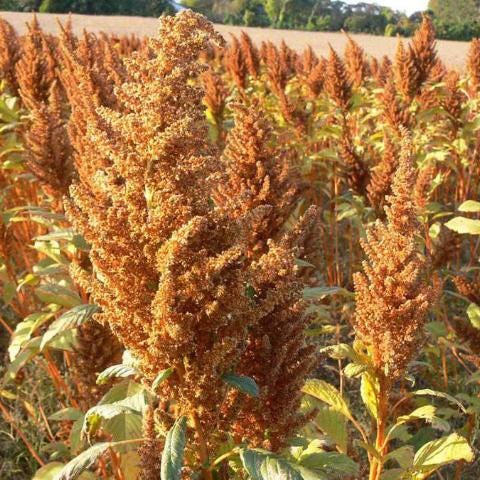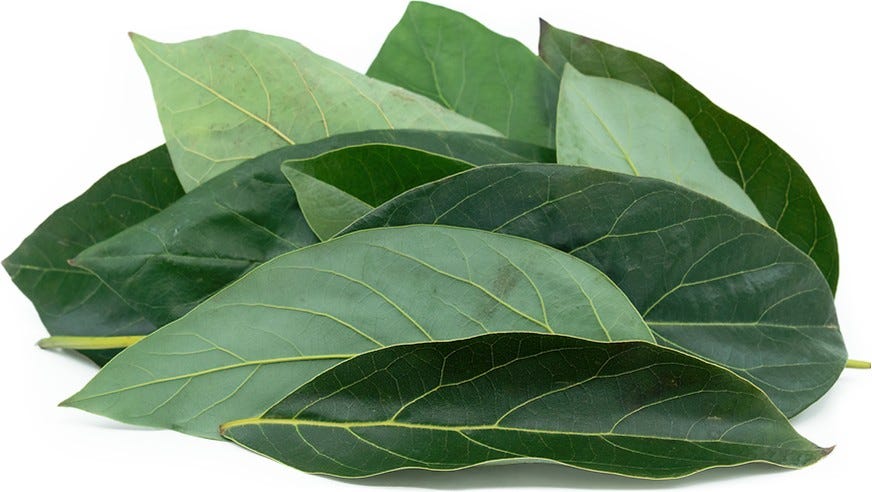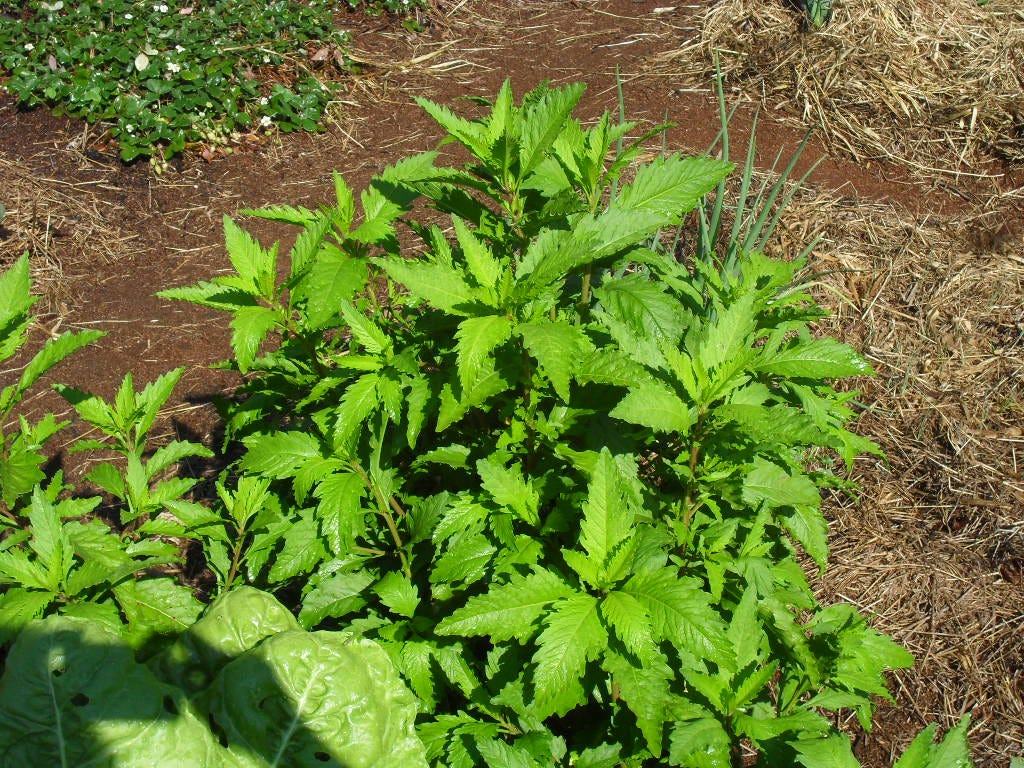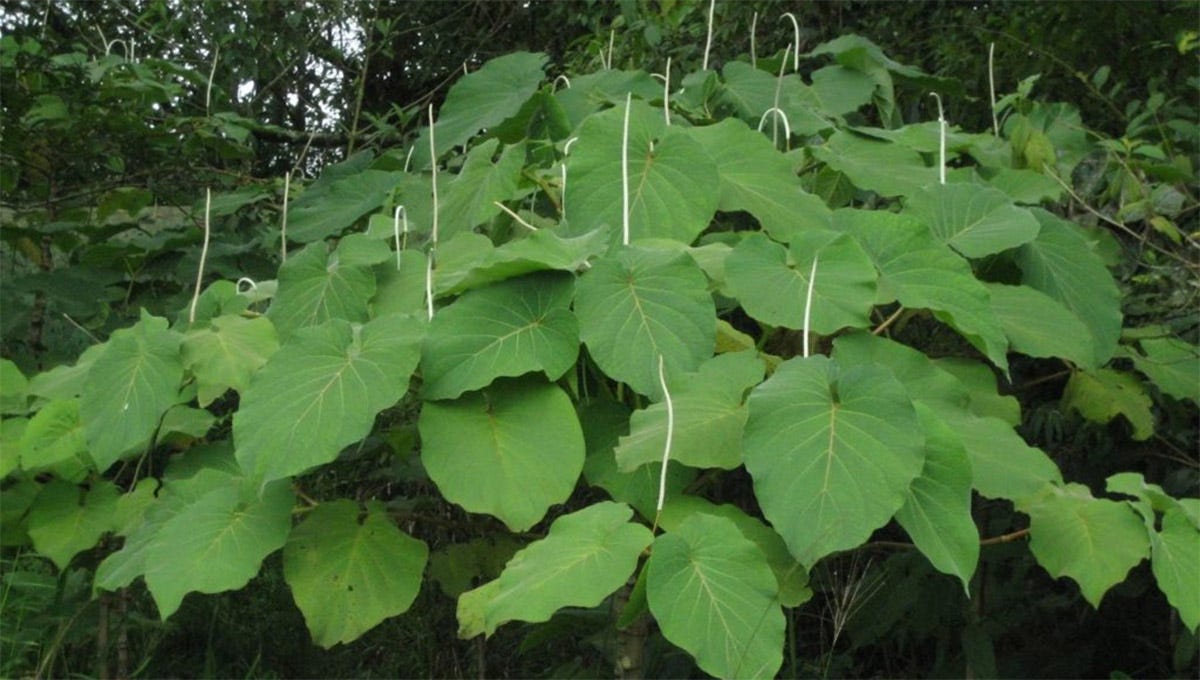A LATIN/MEXICAN HERB & SPICE GARDEN – Part 2: Herbs and Mellow Spices
The Flavors of Mexico, Central America, South America, and the Caribbean

Part 2 of 3
As with all my series on edible plants of a particular cuisine, these are plants you can grow in your own garden, whether you are in the U.S. or in many other parts of the world with a non-tropical climate.
AMARANTH (amaranto and also quelite, bledo and quintonil) (Amaranthus hypochondriacus). Grown primarily for its seeds. Warm season annual in all zones. A. hypochondriacus was a hybrid that underwent allopolyploid speciation (a say-that-fast-three-times term that translates to where the hybrid offspring can reproduce due to a doubling of chromosome sets); the primary parent probably being A. powellii with other species playing some role. The initial cultivated form probably emerged in southwestern North America or Northern Mexico, where A. powellii is native. A. powellii (or similar species) was and is used by the Hopi People of the American Southwest but the Aztecs (Central and Southern Mexico), too, made use of a grain from a similar species.
The toasted grain has an excellent nutty flavor, is great in stir-frys, and can be popped like tiny popcorn. This grain amaranth (along with most other amaranths) is reportedly higher in protein than wheat, rice, or corn. The leaves, too, can be eaten, as spinach is cooked/prepared.
An extremely easy annual plant to grow; maybe too easy, as it can reseed readily. Although it will grow in almost any situation, for seed production, you’ll need fun sun (all day long), lean soil, and progressively less water when it begins to flower.
ANISE (seed) (anis) (Pimpinella anisum). Also called aniseed. An annual grown during the cool season. Anise seeds are a key ingredient in Mexican atole de anis, champurrado, and pan de muertos, or Day of the Dead bread.
Atole de anis is a drink that is made with corn dough, water, piloncillo, anise and guajillo chile. It is a tradition in Morelos and is typical of the Day of the Dead is preferably drunk with a good, freshly baked “Bread of the Dead.” Enjoyed on cold days. One recipe makes it with star anise, a spice native to China and Vietnam and used in plenty of Asian dishes. There’s a similar recipe called Atole de Grano (Mexican Fennel Corn Soup) that is made with fennel (Foeniculum vulgare) leaves and seed.
Champurrado is corn dough melted in water with metate chocolate, toasted and ground corn and piloncillo along with the anise.
Easy to grow with full sun (all day) and plenty of regular moisture. Flowers form as the day length increases and/or temperatures rise, and are followed by the seed.
AZAFRÁN aka MEXICAN SAFFRON, SAFFLOWER (Carthamus tinctorius). One- to three-foot high plant, with a slight resemblance to a thistle. In addition to a yellowish-orange color (pretty much the same color as the flower), this “saffron” adds a subtle nutty-earthy flavor to the dish; milder than true saffron (Crocus sativa). Used to create saffron rice or yellow rice (arroz al azafrán), as well as in soups and stews, both for its coloring and for a subtle earthy note.
This plant’s seed is also the source of safflower oil. The U.S. is the world’s largest producer, India is second, and Mexico is third.
Easy annual in full sun and somewhat drought-tolerant as it comes to maturity. Grows best with long, hot summers. Small sunflower-like seeds are great food for finches and a few other birds.
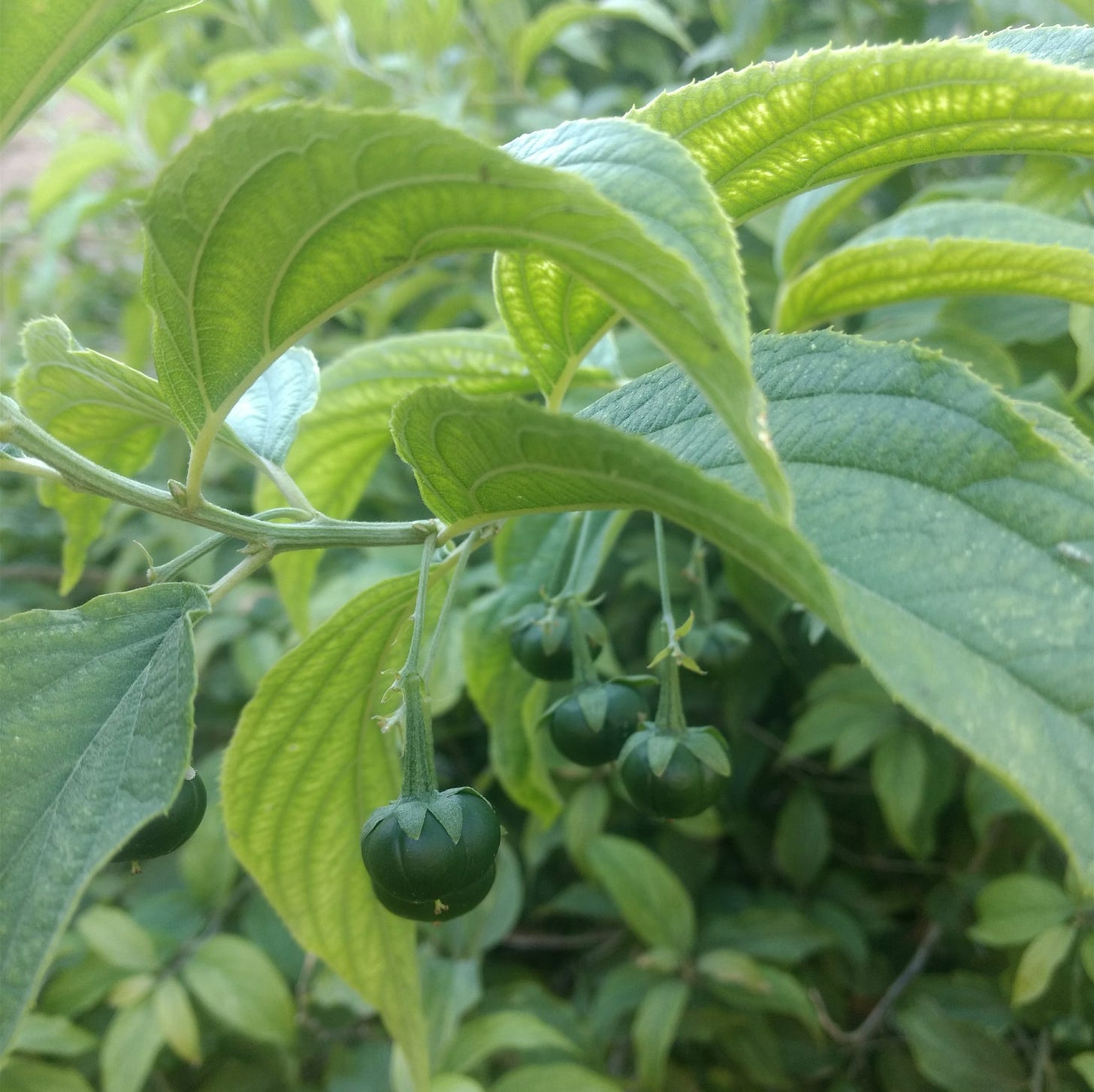
AZAFRANCILLO, AZAFRÁN DE BOLITA (Ditaxis heterantha). Zones 8 to 11. Another azafrán, This one is a member of the Euphorbiaceae family and grows wild only in Guanajuato, Mexico. Its basic kitchen use is as a substitute for saffron (as with azafrán, above, and achiote, below). It’s not related to true saffron (Crocus sativus) nor to the aforementioned safflower (Carthamus tinctorius). Ditaxis heterantha has dull, dark brown seeds ¼ to ½ inch in diameter that resemble allspice; it’s the waxy, deep orange endosperm (the food storage area just beneath the coat) of the seed that is used to color different stews as a substitute for Spanish saffron. It should not be used in large quantities in a dish because it can make it bitter. It is commonly used in the states of Jalisco, Sinaloa, Querétaro, Hidalgo, and San Luis Potosí. Azafrin de bolita is how it is known in Guanajuato, meaning “marble saffron” in reference to its small round seeds.
In Mexico (particularly Guanajuato) it’s used for coloring and flavoring food, such as menudo amarillo.
In the garden, it’s best to treat this as the drought-tolerant subtropical plant that it is: full sun, lean, well-drained soil, regular watering during its growth period, but allow the soil surface to dry out between watering. In the ground, no fertilizer; in pots, you may have to apply some in regular small doses.
ACHIOTE (the plant) or ANNATO (the colorant) (Bixa orellana). Can be grown only on the southernmost tip of Florida and the southwestern most tip of San Diego County in California. It’s a tall shrub to small evergreen tree that can reach 20 to 30 feet high.
The powdery coating of the seed pod is knocked off and then mixed with water to form a paste (recado rojo). This is an important ingredient in the southeast of Mexico (Yucatán and Oaxaca) and in Belize. The paste is dissolved in either lemon juice, water, oil, or vinegar, used as a marinade for meat, or rubbed directly upon it. The meat is then grilled, baked, barbecued, or broiled. Sometimes, it is added to corn dough to create a zesty flavor and color in empanadas and red tamales. It may also be an ingredient when making tacos, al pastor, or chorizo.
When fully mature, the pod dries, hardens, and splits open, thereby exposing the seeds.
Special Note: true SAFFRON (Crocus sativus) is used not uncommonly in Latin cuisines. But it is not much grown there. In comparison to the flavors of the other “saffron” above, true saffron is a wee bit sweet and definitely earthy-pungent (a flavor not to be overdone).
AVOCADO LEAF (Persea americana var. drymifolia; the Mexican Avocado). In addition to the fruit as the source of Superbowl-watching’s favorite dip, the leaves of this natural variety* and only this variety are used in some cuisines as an herb/spice, with a flavor somewhat reminiscent of anise. Hoja de aguacate is used both dried (toasted before use) and fresh, either crumbled or used whole, commonly in bean dishes. In parts of Mexico, specifically the southern states of Oaxaca and Puebla, leaves are added to tamales, moles, pipianes (sauces made with seeds and nuts), soups, and stews. They are also layered into casseroles, used as a bed for roasting meats, and wrapped around fish, chicken, and meat when grilling. Some leaves are more pungent that others, so start with a conservative amount, anywhere from one teaspoon of ground leaf to 1 whole leaf for an entire pot of beans or stew meat. If you want a stronger flavor, simply add more.
* The Mexican avocado is now considered a “landrace” rather than a natural variety (the word “variety” in this taxonomic sense should not be confused with what is technically a “cultivar”). This specific landrace, one of three, is called the Mexican avocado (or aoacatl) and, should you wish to buy an appropriate tree, some of its cultivars are ‘Aravaipa’, ‘Bacon’, ‘Del Rio’, ‘Duke’, ‘Joey’, ‘Lila’, ‘May’, ‘Opal’, ‘Mexicola Grande’, ‘Poncho’, ‘Royal-Wright’, and ‘Zutano’; there are more. Sorry, ‘Haas’, everybody’s favorite guacamole egg, doesn’t fit here (but Mexican avocado is used as a rootstock for Haas trees and is used in hybridizing work with the other races).
Fruits of the Mexican race, the hardiest of avocados, have dark, smooth skin, and the trees are hardy, capable of withstanding cold weather to 21°F, as well as tolerating poor growing conditions.
The other two landraces, those which do not have edible leaves, are the Guatemalan (quilaoacatl) and the West Indian (tlacacolaocatl). CAUTION: Leaves of Guatemalan avocado are actually toxic.
BAY LEAF aka GRECIAN BAY LAUREL or LAUREL (Laurus nobilis). Zones 8 to 11; can get damaged at the cold end of this zone range.
This species is grown fairly commonly in Mexico and used in the kitchen – but because there are other “bay leaf” species (next two entries), I am not sure if commonly, regularly, or uncommonly.
This bay leaf entry took me down a rabbit hole of research. One thing led to another.
It may have started with two frequent complaints I hear: Do bay leaves really give the food any flavor and Why do my store-bought bay leaves taste different from batch to batch? The reasons are a few...
1. There’s more than one kind of edible bay (laurel) leaf. In fact, there’s several. There’s this one (Laurus nobilis). There’s also California Bay Laurel (Umbellularia californica). And then there’s the next two, the West Indian Bay tree (Pimenta racemosa) and the Mexican Bay Leaf (Litsea glaucescens). The last two are discussed in the next entries but here’s a bit on the California Bay (which is a common topic of California conversation when “Grecian” laurel is brought up)…
Many Californians forage for California Bay Laurel (including within urban areas). The leaves are also sometimes, not often, available commercially – almost always sold as just “bay leaf.” They’re the longer, more narrow ones.
“Chemically” speaking, 1,8-cineol is the primary essential oil and flavoring in Laurus nobilis. Laurus nobilis contains 57% of this compound while U. californica has only 20% of the essential oil (flavoring).
Conversely, umbellulone is 37% of the essential oil in U. californica, but it isn’t found in L. nobilis at all. Umbellulone isn’t just a unique flavor; it’s also a headache-inducing monoterpene ketone; I know the reaction well.
California bay also contains methyleugenol, thymol, and α-terpineol at 8.4%, 7.8%, and 6.5%, respectively, but are mostly or entirely missing from oil of L. nobilis.
Many people I’ve bumped into have talked about, academically, the use of California Bay Laurel in the kitchen but I’ve never seen anybody actually use it.
2. Where they were grown and when they were picked (the stage) makes a difference in flavor. Under the hot and dry conditions that tend to characterize their native Mediterranean summers, aromatic plants such as bay produce larger quantities of essential oils (the chemical substances that are responsible for the plants’ characteristic aroma and flavor). As such, laurel leaves that have been sourced from wetter and cooler climates, such as the U.K. early in the year, are unlikely to have anything like the same sensory qualities as their Mediterranean counterparts picked at the end of a long dry hot summer. This is why the type labeled as “Turkish Bay Leaf” (still Laurus nobilis) is superior. [Other Mediterranean aromatics include sage, rosemary, thyme, oregano, and the like.]
3. The amount of time that has passed since the leaves were picked — storage — also makes a difference. There’s fresh leaves, straight off the tree; it takes three times the amount of fresh leaves to equal the amount of flavor-imparting quality of dried leaves called for in a recipe. On the other hand, there’s old dried leaves that have sat in the open somewhere for who knows how long; even the evaporation-resistant oils have decayed. And there’s the in-between time lapses with the corresponding measure of flavor. There’s also fresh-frozen and, believe it or not, dried-frozen. One study showed dried-frozen (as long as it wasn’t dry for too long before freezing, had the best flavors.
I use bay leaves (Grecian) regularly and I always smell it while it’s cooking in a stew and I taste the results of it when I sit down to the stew. There’s something deeply meaty about it.
In addition to the flavors released into the food, bay leaves have well-established antibacterial, anti-microbial, anti-oxidant, anti-inflammatory, and even analgesic properties.
Laurus nobilis is a problem-free plant when grown in its range. Best in full sun (for growth and for development of essential oils and, hence, flavors) but will tolerate quite a bit of shade. As with most Mediterranean natives, it likes a lean soil, minimal feeding, if any, and watering only occasionally once established.
WEST INDIAN BAY TREE aka BAY RUM TREE, CILIMENT (Pimenta racemosa) is a species of plant native to the Caribbean region. It is unrelated to Laurus. Zones 10 and 11 (strictly southern Florida, where it does best, and Southern California).
More fragrant and flavorful than all the other bay leaves. Its flavor is intense and highly spiced, with complex notes of cinnamon, clove, and nutmeg along with hints of vanilla and cardamom. (By the way, that combination of spices is pretty much the same as that found in the dried fruit/seed of this plant’s cousin, Pimenta dioica, the plant we call ALLSPICE.)
In cooking, West Indian Bay leaves are used in the making of jerk chicken in the Caribbean Islands, not so much as an actual ingredient but rather as part of the process. The leaves are soaked and placed on the cool side of the grill. Pimento “sticks” (small branchlets) are then placed on top of the leaves, and the chicken is placed on top of that, and smoked. The leaves are also used in marinades, rice dishes, spice cakes, pickles, soups, stews, and many other Caribbean dishes.
In addition to its use in cooking, it produces a distilled essential oil used to produce a fragrant cologne called bay rum (although the name is similar to names of flavored alcoholic beverages, the concentrated essential oil from the fruit is toxic and renders the product undrinkable.) And yet the leaves are used for herbal teas.
West Indian Bay requires full sun (it’s spindly in any shade), a warm humid summer, a slightly acid soil, and regular watering.

MEXICAN BAY LEAF (Litsea glaucescens). Zones 8 to 11, will tolerate short periods of frost, but not extended cold. It’s an evergreen tree or shrub, 5 to 10 (or sometimes 20) feet high. It is found native in mountain ravines in south-central Mexico.
Mexican bay leaf was known to the Aztecs as ecapatli, a Nahuatl word meaning “wind medicine.” Later, it was called, by the Spaniards, falso laurel (false laurel) and laurel de la sierra (mountain laurel) to distinguish it from bay laurel (Laurus nobilis). Over-harvesting for Palm Sunday decorations and for food has threatened this wild laurel, which is now protected by law in Mexico.
This is the preferred “bay leaf” for Mexican cooking. The flavors of Mexican bay leaves resemble those of bay laurel, but are milder and more subtle. In Mexico, the leaves are used whole in soups, marinades, and slow-cooked meat dishes.
While it is found fresh and sometimes dried in Mexico, only whole dried leaves can be found (and then only occasionally) in the U.S.; definitely time to grow your own.
Likes full sun (all day) and water during the active growing season. Might need some winter protection for young plants in Zone 8.
CILANTRO, CORIANDER (Coriandrum sativum). Annual anywhere, during the cool season. The common names cilantro and coriander can be synonymous or different culinarily. While “cilantro” is the Spanish word for fresh leaves of Coriandrum sativum, “coriander” can refer to just the seed (whole or ground as a spice) or it can be used for both seed and fresh leaves (plus, in the parts of the world where used, it can include the roots, too). Most cooks/chefs in the U.S. use cilantro for the leaves and coriander for the seeds. Of course in the rest of the non-English-speaking and non-Spanish-speaking world, cilantro and coriander are replaced with whatever word is used in the native tongue. Spice note: although leafy garden plants will eventually flower and produce seed, most seed grown for the commercial spice trade are from plants of selected types/varieties that have larger seeds.
Cilantro bears a unique flavor. On the one hand, it’s described as citrusy, earthy, and slightly peppery, with hints of fresh greenery. On the other hand, about half the population thinks cilantro tastes “soapy” or even “rotten;” certainly genetics (due to variations in the gene OR6A2) and culture are at hand here. If you’re not already a cilantro lover and want to get to know Latin (and Chinese and SE Asian) food better, start by mixing small amounts into dishes (rather than topping) and going from there. It’s the unsaturated aldehydes in cilantro that cause the yuck response in those who would rather live without this herb.
Speaking of aldehydes, cilantro’s chemical composition confers antioxidant, anti-inflammatory, and antiseptic properties. This herb also helps produce digestive enzymes that ease bloating and indigestion, making it a good supplement for gut health.
In cooking, you can use the tender, aromatic leaves or, for more robust flavor, the stems. Cilantro when used in moderation (much as with garlic!), adds depth and complexity to dishes.
Cilantro is nearly ubiquitous in Latin American food and is a key flavor in iconic dishes such as Mexican salsa verde and arroz verde (green rice) and Peruvian aji verde (spicy green sauce). I don’t think any other herb (unless you consider chile an herb) defines Mexican cuisine more than cilantro. It’s used extensively in Mexican cooking, particularly in preparing sauces. It’s added to tacos along with onions, radishes, and lemon juice. Chop it and it’s sometimes used as a garnish.
In Argentina, the official “National Meat Topping” known as chimichurri sauce is loaded with cilantro.
In Nicaragua and the Dominican Republic, where the cuisine is milder than the other Caribbean states, cilantro is the kick-it-up flavoring in what might otherwise be “bland” food. In the Dominican Republic, there is also pico y pala (chicken feet and necks cooked with onions, culantro, oregano, sugar, and cilantro) and guisados (meat, fish, beans, or vegetables cooked in a tomato sauce base with Dominican-style sazón (seasoning), and small amounts of sour orange or lime juice and sugar). Guisados also use plenty of coriander seed in their preparation.
Cilantro needs cool (not cold) weather, sunshine, and plenty of water. Without such, plants are subject to “bolting” (which is when plants flower ahead of their time without putting on much vegetative growth). If you’ve struggled with bolting, you can employ these strategies to (maybe) get around it:
Sow cilantro in early spring or fall when temperatures are cooler. I mild winter areas, it can be grown as a winter crop.
Don’t use transplants; they’re easily stressed.
Provide partial shade during the hottest part of the day.
Use mulch to help keep the soil cooler.
Keeping the soil consistently moist can help prevent bolting.
Grow cilantro successively: sow a very short row then, 2 weeks later, sow another short row, and repeat until the weather is forecast to get warmer (or much colder) within 3 weeks.
Harvest cilantro regularly and harvest whole plants when small.
While you’re at it and you have large plants, harvest some roots, as well. Cleaned thoroughly, they’re great in curries (an Asian thing).
CULANTRO (Eryngium foetidum). A biennial hardy in Zones 8 (maybe 7) to 11. In some Latin countries, it is called cilantro ancho and, where harvested from the wild, culantro sylvestre.
Culantro has a more pungent flavor than cilantro hence why it’s used in smaller quantities as a flavor base or garnish. It’s common in Puerto Rican cuisine where it’s a primary ingredient in recao (a sofrito but sometimes used as the common name for culantro) or recaito (Caribbean sofrito). Culantro is sometimes used in the making of callaloo, a soup/stew made with the large leaves of the same plant from which we get taro; another signature Caribbean dish.
You can use culantro in a Caribbean or Latin American-style marinade such as mojo criollo, a citrusy Cuban marinade typically made for pork. It’s also an ingredient in many salsas/sauces and condiments, including variations on the Argentinian chimichurri.
As a biennial, culantro is sown direct in late summer into early fall in Zones 9 and 10 and maybe 8 but in Zones 7 and maybe 8, it would be more dependably sown in early spring. Best in sun and with plenty of moisture.
CITRUS (several Citrus species and hybrids). Zones 9 to 12. Lime, lemon, and orange are the primary types, while plenty of other citrus, mostly unknown in the U.S., are used in several parts of Latin America. Used to brighten the other flavors of many dishes as well as to “cook” the popular dish ceviche, which is raw fish that has had its proteins chemically denatured with acid (essentially, the proteins pull apart, making the fish “tender”).
The most commonly used citrus for making ceviche is lime. Lime also seems to be the go-to citrus for garnishes, for preventing the oxidation of guacamole (Latin chefs, by the way, don’t use it in fresh guacamole that’s to be eaten right away), for marinades beyond ceviche, and for drizzling over tacos, carnitas, fajitas (NOT real Latin American food), carne asada, pozole, birria, and caldo tlalpeño (chicken, bean, and vegetable soup), to name a few of the many lime-enhanced dishes.
The naming of the basic citrus from Mexico south can get confusing. When I took Castilian Spanish in high school, I learned that “limón” was lemon and “lime” was lime. Since then, I learned that the word “limón,” which by the look of it would seemingly mean lemon, actually refers to lime. Limes can be “limón verde,” while their sweet lemons, which we don’t have in the U.S., are called “limón amarillo” or “ Sweet limes (no acid) are “limettas” (in actuality, they are lemons, botanically and they do turn yellow).
Those sweet lemons, by the way, are, botanically, sweet limes but are not called limettas; in addition to being called “limón amarillo,” they are called, most literally, “lima dulce.” Because typical lemons are sour, they are considered limes, hence they are called “lime” or “lima.” Your dis-Spanish lesson of the day.
All citrus require full sun (all day), regular watering during their active growth and into flowering, and feeding from February or March, monthly into August (in climates with no frosts, it can be any month where there is active growth). For those who grow them in containers and somehow protect them in winter, there are many more rules to follow than that but I’ll cover those rules in a future article.
EPAZOTE (Dysphania [Chenopodium] ambrosioides). Warm season annual but a short-lived perennial in Zones with hot summers and not-so-cold winters. Epazote is a Latin American native herb most common in Mexican cuisine. It’s often described as tasting peppery or minty with a hint of basil and floral notes, and is known to reduce gas (although this gas-reducing ability doesn’t seem to work in all foods nor in all ways; no credible research has shown it to have any effect on the gassiness from eating beans cooked with epazote.)
Gassiness aside, epazote provides a distinct flavor to several Latin dishes including tortilla soup, chilaquiles de guajillo (a breakfast specialty of corn tortilla chips, smothered in a tomato and chile salsa, and topped with an egg), salsa de queso (a special dippable cheese sauce), tamales, mole verde (a green sauce not to be confused with salsa verde, which doesn’t include epazote), and quesadillas, especially those made with corn tortillas and very especially huitlacoche quesadillas (huitlacoche being the mushroom that grows on corn kernels while still on the living plant).
Epazote is used daily in such places as Oaxaca, Yucatán, and Guatemala. It’s said that Oaxacan cuisine owes its unique flavor to epazote.
Epazote loses most of its flavor when it’s cooked for too long; hence why it should be thrown in near the very end of a recipe. CAUTION: large amounts of epazote are known to be toxic; in other words, don’t use it for “medicinal purposes.”
Epazote is a leafy herb that can be grown as either an annual or a short-lived perennial plant, depending on its environment. If grown as an annual, make successive sowings and harvest leaves regularly when near maturity. It can reseed itself in affable climates.
GARLIC (ajo) (Allium sativum). Almost all Zones. An omnipresent ingredient in Latin American cooking, it’s used in a wide variety of dishes across the region, often alongside onions, and considered a key element to add depth of flavor to many meals. It’s found in salsas, adobo, marinades, and even basic cooking bases such as sofrito and recaito. Argentina’s chimichurri sauce, is composed of olive oil, red wine vinegar, parsley, red chilies, oregano, and, of course, lots of garlic.
For more garlic info including how to grow, see the article on garlic: “Garlic, Leeks…”
HOJA SANTA, MEXICAN PEPPER-LEAF Piper auritum. Zones 9 and 10, maybe 8 with root protection in winter. A bold and attractive evergreen herbaceous shrub to 8 or more feet tall and spreading wide by rhizomes, holding aromatic heart-shaped velvety leaves that can be up to a foot long or more. Complex flavors compared to eucalyptus, licorice, sassafras, anise, nutmeg, mint, tarragon, and black pepper. That’s a whole spice rack. (CAUTION: Might have negative reactions in some people; please don’t smoke this stash.)
This herb is most often used fresh and usually cooked (the veins are too tough to be eaten raw) yet the leaves remain green and retain their flavor when heated. Dried leaves can be used as a seasoning, though not as flavorful as the fresh. Chopped hoja santa is incorporated in a wide variety of Mexican stews and is occasionally cut into very fine strips to be used as a condiment for soups and egg dishes (such as the traditional huevos encamisados). It’s a common ingredient in mole amarillo (yellow mole), mole verde, barbacoa, and salsa a la Veracruzana for fish.
The fresh leaves are also used to wrap and flavor cheeses, and to wrap tamales, meats, and fish for steaming or baking. For wrapping, rinse the leaves well and slice along both sides of the central vein. Wrap the resulting two lobes around the food and eat along with the filling.
The plant requires full sun (all day) to part shade with plenty of moisture during the active growing season. As it matures, keep after wayward rhizomes.
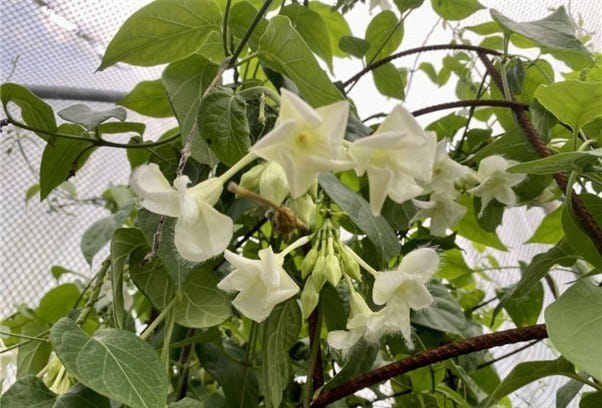
LOROCO (Echites panduratus). Zones 9 to 12 with summer humidity; in cooler regions, it can be grown in containers and moved indoors during the winter. An evergreen climbing vine with a long season of bloom; nearly everblooming once mature. Although roots can be poisonous, flowers and flower buds are quite edible, with a flavor reminiscent of artichoke and chard, with a floral sweetness and a bit of a tang. The buds and flowers are used for cooking in several ways, including in quesadillas and especially in pupusas (thick but soft flatbreads, like pillowy tortillas, stuffed with various goodies), a signature dish of El Salvador and Honduras.
Best in full sun but does okay in part shade. It’s a sturdy tendril-climbing vine requiring a sturdy support with cross structures onto which the tendrils can wrap around easily. Will need plenty of moisture during the active growing season (just don’t keep it boggy). During the down season, prune a little to keep it neat and clean.
¡Buen provecho!
CLOSING NOTE: The mention of five familiar herbs (and one flavoring fruit) within this article highlight what is called the Columbian Exchange. I certainly don’t like the “politics” of that history but there was a great impact on botany, agriculture, and the cuisines at that time. Those six familiar herbs – anise, azafran (safflower), bay leaf (Grecian), cilantro, citrus, and garlic – have become a big part of “traditional” (not authentic) Latin American cuisine.
Next week: MARJORAM, three OREGANOS, PÁPALO, PARSLEY, PEPICHA, HEIRBA BUENA, MEXICAN TARRAGON, THYME, and WACATAY.
© Copyright Joe Seals, 2025




